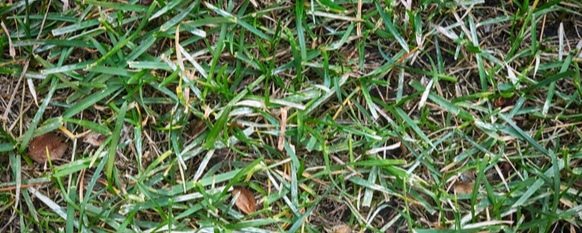Have you ever gone out to peruse your plants or gaze upon your yard and become taken aback at a strange substance that covers the petals, leaves, or grass blades? Perhaps you saw a white powdery coating on your plants or lawn and were puzzled about where it came from suddenly.
You’re not alone.
What you’ve most likely encountered is powdery mildew. Formed from a fungus, this bizarre addition to your lawn can spread quickly throughout a wide variety of plants and can be detrimental to the health of your lawn and garden.
Here we’ll detail what this fungus is, how to deal with it, and how dangerous it may be to your family and pets.
After dealing with this fungus, you’ll also want to check out our other lawn care guides. For instance, we have a guide on whether you should be mulching or bagging your grass clippings.
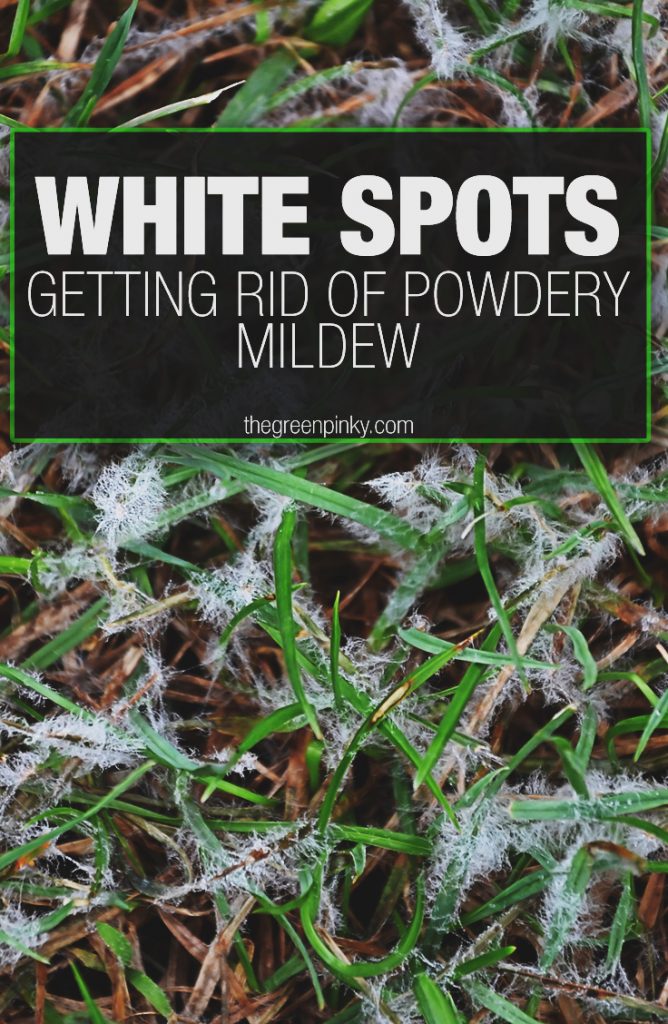
What is Powdery Mildew?
The white powdery mildew that you see on your grass blades or leaves of your vegetation is a fungal disease that, if left untreated, can bring a load of heartache to you and your lawn. This growth develops best in cool-season grasses like Kentucky bluegrass and plants that grow in higher amounts of shade and moisture.
As its name indicates, the fungi appears as a white or light gray dust-like coating on turfgrasses and plants. Powdery mildew favors conditions with moderate air temperatures and high humidity. Therefore, they thrive in areas with poor air circulation areas in combination with the aforementioned shade and moisture.
Powdery Mildew Disease Cycle and Symptoms
Powdery mildew will first appear as light spots on grass blades or on the leaves of plants, trees, and shrubs. As powdery mildew symptoms worsen, the infected areas will look as if they have been spray-painted or dusted. The “dust” is actually millions of spores of the fungus.
If the outbreak of powdery growth is severe enough, large sections of turfgrass will look as if they have been coated with the fungi. Older plants are more susceptible to infection than their younger counterparts. Over time, infected leaves will turn yellow and eventually brown as they die off.
When Does Powdery Mildew Appear?
Because powdery mildew prefers cool, humid temperatures and little to no air circulation, it most commonly occurs during the spring and fall months. The weather in the summer is too hot for the fungi to survive. During the winter months, the spores will go dormant and overwinter by seeking refuge in buds or other sheltered parts of plants.
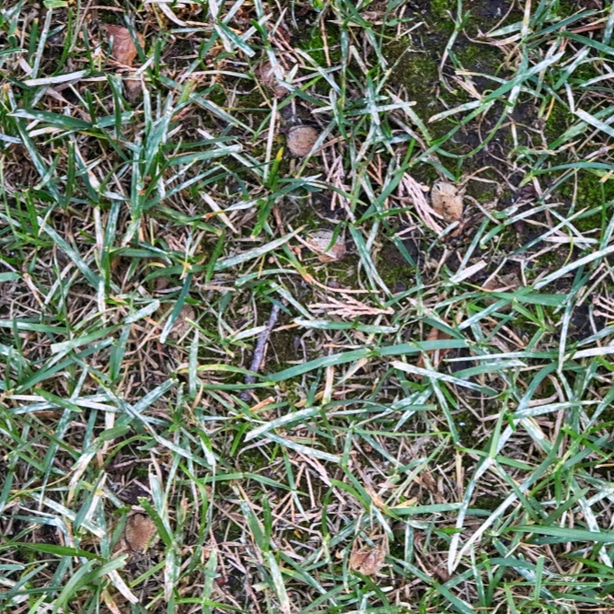
What Causes Powdery Mildew?
The fungus Erysiphe graminis causes a powered-looking growth on different turfgrass species and is considered an obligate parasite; these parasites can only survive on a living host or turfgrass plant. The development of the fungus is favored by reduced air circulation, high relative humidity, shade, and moderate air temperatures.
Under these favorable conditions, the mold will produce millions of asexual spores called conidia on the surface of infected leaves. Although the fungus prefers little to no airflow, the conidia are spread to other plants by the wind. They are fast-acting and will successfully infect their host within 2 hours of contact.
What Plants Are Vulnerable to Powdery Mildew?
The powdery-like infection is commonly found in cool-season grasses. This is especially true for Kentucky bluegrass, other bluegrass varieties, and different fescues (tall fescue, fine fescue, etc.). The fungus can infect any plant, but some of the more susceptible plants are roses, hollyhock, begonias, apples, lilacs, and some vegetable plants.
Since the growth is host-specific, it is picky about what it will feed on. If you find it on your roses in your garden, it will not spread to the other plants around it. The fungal disease is specific to the plant it is infecting.
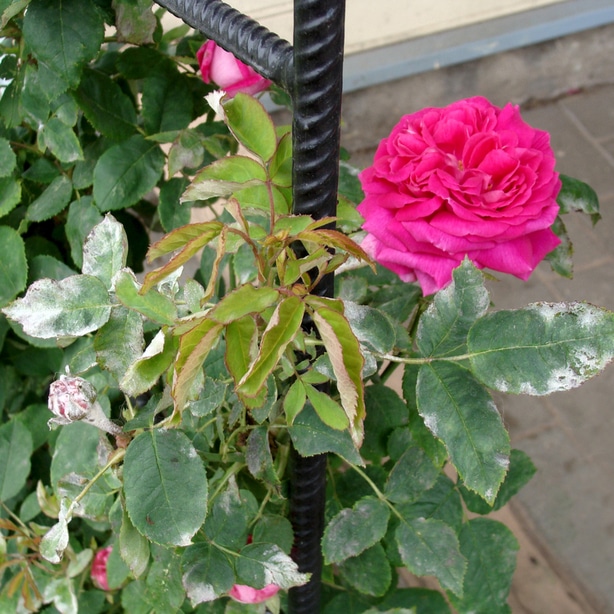
Problems Caused by Powdery Mildew Infection
The first problem is the plants’ unsightly appearance brought on by the drastic change in the color of your plants and shrubs. Despite the unattractive hue of the fungus, the effects of the disease are rarely fatal to your plants. If left untreated, however, the powdery mildew can cause undue stress to your plants.
Over time, or with repeated infections, your plants can weaken to the point of dying out. If it coats the leaves of your plants or blades of grass thick enough, it can block the sunlight from reaching the plants. This will disrupt photosynthesis.
When photosynthesis is disrupted, leaves will fall prematurely from the plants and decrease the growth rate. It can prove to be an even bigger problem for edible fruits and vegetables. If they are deprived of photosynthesis, the number of sugars produced could be diminished and tamper with the flavor of the fruit or vegetable.
Powdery mildew is a living thing and, as such, needs nutrients to survive. While most fungal growth is restricted to the infected leaf’s surface, the fungus can develop haustoria (sucker-like adaptations) that will invade the outer leaf cell structures and leech nutrients from the plant.

How to Treat Powdery Mildew
As with most lawn care problems, the best way to treat powdery mildew problems on your turf is preventative maintenance. This can include opening up shaded areas around your lawn to allow more sunlight to reach the grass. Opening up those areas will also allow for better air circulation and movement through your lawn.
Here are a few more ideas, techniques, and tips to keep in mind to treat powdery mildew on grass and other plants.
Cut Back Your Nitrogen Fertilization
Plants and vegetation that are grown in the shade do not use as much nitrogen as those that are grown in the sun. Reduce the amount of nitrogen fertilizer that you use in areas with lots of shade. Excess nitrogen can weaken the grass or plants and impede their healthy growth.
Watering the Area Correctly
Water patches of shaded grass less frequently than you do the rest of your lawn. The shade is keeping the water from evaporating at the same rate as unshaded areas. Ensure that you are watering the shaded grass deeply. Ideally, you’ll want the water to absorb into the soil at a depth between 6″ and 8″.
It’s also essential to give the shaded grass and plants plenty of time to dry before nightfall. Watering too late into the evening provides ideal conditions for powdery mildew to take hold and make your lawn more susceptible to other diseases. So water your lawn earlier in the day.
Let the Grass Grow a Little Taller
Allow your grass to grow a little taller than usual before you mow it. This extended period of growth makes your lawn more resistant to disease and better able to handle the stress of growing in shady areas. In these sections, allow the blades to grow 1″ higher than if they were growing in full sunlight.
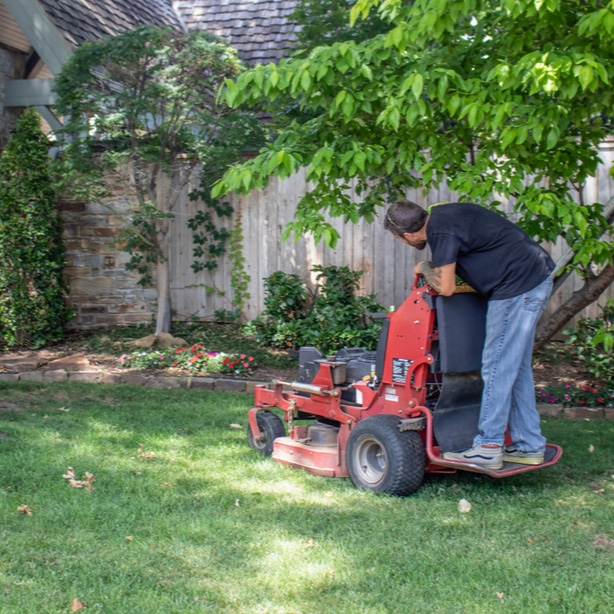
Set the Area Up for Success
Choose plants that are shade tolerant and resistant to diseases to go into shady areas. When planting, be sure to give each plant proper spacing to allow for better circulation.
Inspect the vegetation in these areas regularly and remove any leaves or stems showing symptoms of infection. Catching the powdery mildew early can keep it from overtaking the entire plant.
If you choose varietals that are more susceptible to disease, place them in a location where they will receive as much of the morning sun as possible. This will ensure that the dew from the night will evaporate from the leaves quickly and reduce the moist conditions that favor powdery mildew and other diseases.
If you find that it’s not possible to open up the areas where it’s difficult for grass to grow, using an attractive mulch is another viable option. Using mulch in combination with shade-tolerant plant varieties, you create conditions that are less hospitable for powdery mildew to take hold.
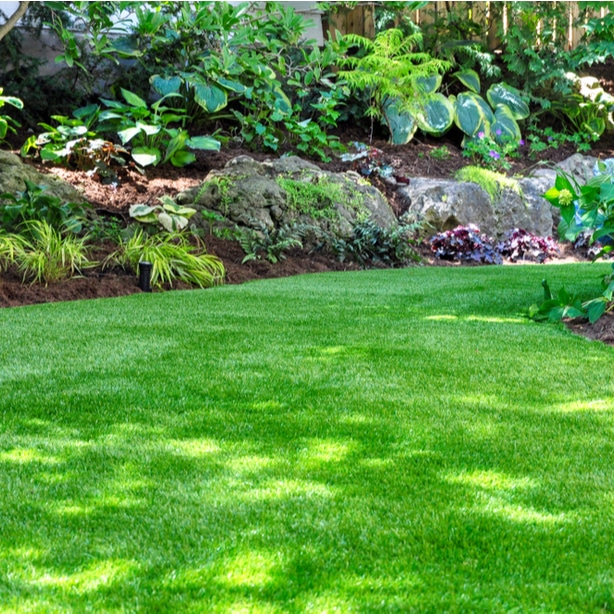
Chemical Applications
Surprisingly, chemical fungicide applications have proven to be mostly ineffective in combating the mold’s growth. The most effective means of controlling the fungal powder are physical and preventative (like what you found above). There are a couple of spray on applications that you may find helpful when used in combination with the previously discussed methods.
Neem Oil
Neem oil is an organic treatment that you can purchase in most garden centers. By applying neem oil, you treat the existing infection while also preventing future problems with the powder.
Baking Soda
By mixing ¼ of a teaspoon of baking soda with 1 quart of water, you will create a solution that can protect your plants from future damage. It is suggested that you spray the plants weekly and at the first sign of infection.
Milk Spray
Fill a spray bottle with 60% water and 40% dairy milk to spray onto the leaves of your plants. This solution has antifungal properties and is best used to prevent an infection. Once the infection has occurred, the milk spray is not as useful.
Is It Harmful to Dogs and Cats?
Mold is one of those things that can be very toxic and deadly (black mold) or be very beneficial (penicillin) or lie somewhere in between. While powdery mildew is unattractive and damages vegetation in severe cases of infection, it is not toxic to either people or animals that come into contact with it.
The fungus can prove harmful to potential food sources by causing the flowers that become fruits and vegetables not to bloom at all. If an infected plant manages to produce a fruit or vegetable, it will probably be smaller and have an inferior taste when compared to the yield from uninfected vegetation.

